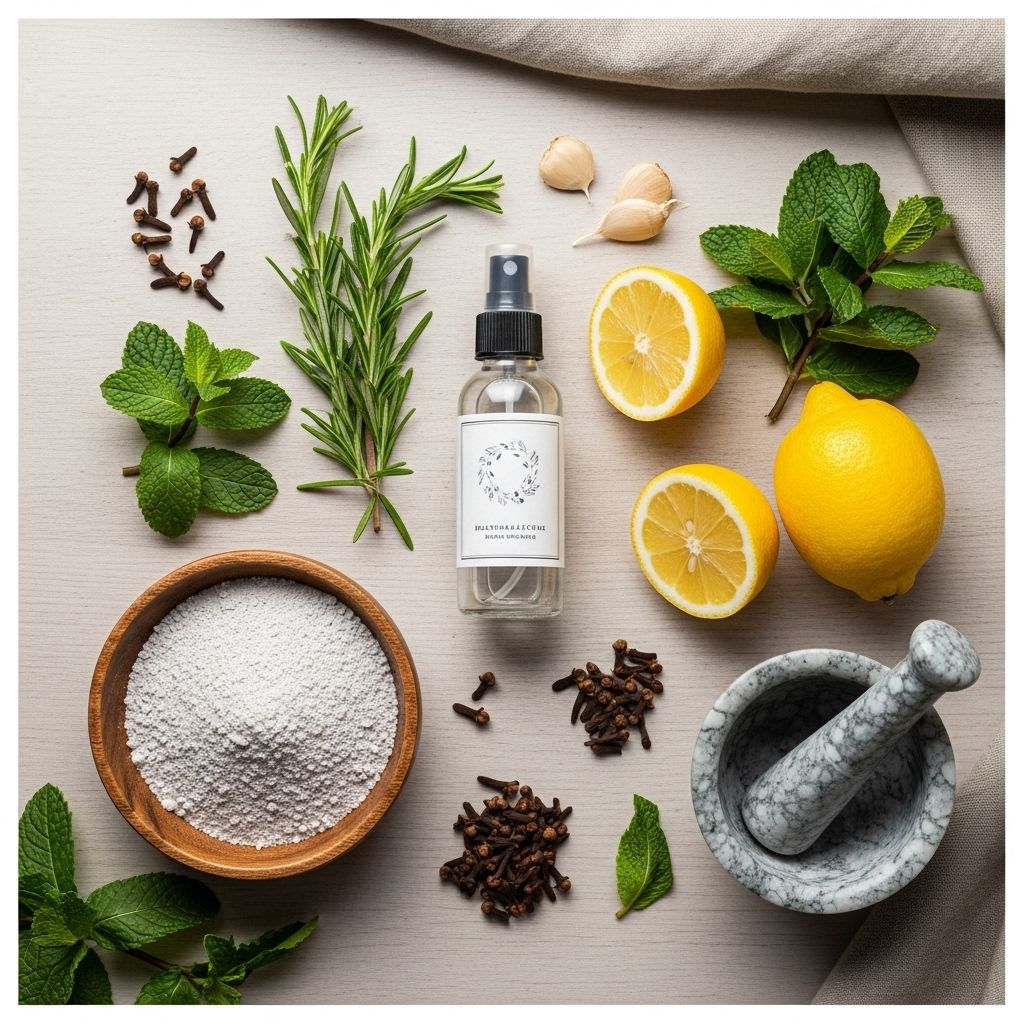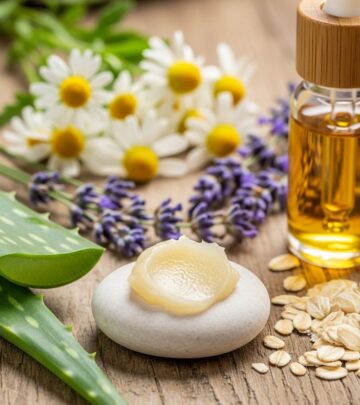5 Powerful Natural Remedies to Eliminate Fleas from Your Home
Discover safe, chemical-free solutions to banish fleas naturally

Dealing with a flea infestation can be frustrating and overwhelming for any pet owner. These tiny parasites multiply rapidly and can quickly turn your comfortable home into an uncomfortable environment for both you and your furry companions. While commercial flea treatments are readily available, many pet owners are increasingly turning to natural remedies that are safer for their pets, children, and the environment. Natural flea control methods offer effective solutions without exposing your household to harsh chemicals and synthetic pesticides.
Fleas are remarkably resilient creatures that have adapted to survive in various environments. Understanding their lifecycle and behavior is crucial to effectively eliminating them from your home. A single female flea can lay up to 50 eggs per day, which means an infestation can escalate rapidly if not addressed promptly. The good news is that several natural remedies have proven effective in combating these persistent pests while maintaining a safe living environment.
Understanding Flea Infestations in Your Home
Before diving into natural remedies, it’s essential to understand how fleas operate and why they’re so difficult to eliminate. Fleas don’t just live on your pets; they infest carpets, furniture, bedding, and any fabric surfaces where they can hide and reproduce. The flea lifecycle consists of four stages: egg, larva, pupa, and adult. This complex lifecycle means that you’re not just dealing with the adult fleas you can see on your pet, but also with eggs and larvae hidden throughout your home.
Statistics reveal the severity of flea-related issues, with illnesses from flea bites surging significantly in recent years. Between 2004 and 2016, over 640,000 cases of illnesses from mosquito, tick, and flea bites were reported in the United States alone. This alarming trend highlights the critical importance of addressing and preventing flea infestations promptly and effectively.
Natural remedies work best when implemented as part of a comprehensive flea management strategy. This includes treating your pets, cleaning your home thoroughly, and using natural repellents to prevent reinfestation. The key to success lies in consistency and patience, as natural methods typically take longer to show results compared to chemical treatments but offer safer alternatives for your household.
Remedy 1: Baking Soda Treatment for Carpets and Furniture
Baking soda stands as one of the most accessible and cost-effective natural remedies for flea control in your home. This common household ingredient works by dehydrating fleas and their eggs, disrupting their ability to survive in your carpets and upholstery. The mechanism behind baking soda’s effectiveness lies in its ability to absorb moisture, which is essential for flea survival.
To use baking soda effectively, liberally sprinkle it over all carpeted areas, rugs, and upholstered furniture where fleas might be hiding. Pay special attention to areas where your pets spend the most time, as these locations typically harbor the highest concentrations of fleas and eggs. Use a stiff brush to work the baking soda deep into the carpet fibers, ensuring it reaches the base where flea eggs and larvae reside.
Allow the baking soda to sit on surfaces for at least several hours, though overnight treatment yields better results. During this time, the baking soda works to dehydrate any fleas, eggs, or larvae present in the treated areas. After the waiting period, thoroughly vacuum all treated surfaces, making sure to empty the vacuum bag or canister immediately into an outdoor trash receptacle to prevent any surviving fleas from reinfesting your home.
While baking soda can help control flea populations by dehydrating them and disrupting their environment, it’s important to understand its limitations. Baking soda alone is unlikely to completely eliminate a severe flea infestation. It works best as part of a broader flea control plan that includes regular cleaning and possibly other natural or professional treatments for more persistent cases. Repeat this treatment weekly for several weeks to break the flea lifecycle and achieve optimal results.
Remedy 2: Salt as a Natural Flea Dehydrator
Salt operates on a similar principle to baking soda, making it another excellent natural remedy for controlling flea infestations. When sprinkled on carpets and upholstery, salt absorbs moisture from fleas, effectively killing them through dehydration. This method has been used for generations and remains one of the most reliable chemical-free approaches to flea control.
The application process for salt treatment closely mirrors that of baking soda. Use finely ground table salt rather than coarse salt, as the smaller particles can penetrate deeper into carpet fibers and make better contact with fleas and their eggs. Generously distribute the salt across all carpeted areas, focusing particularly on high-traffic zones and your pet’s favorite resting spots.
For maximum effectiveness, allow the salt to remain on treated surfaces for a minimum of two to three days. This extended contact time ensures that the salt has sufficient opportunity to dehydrate fleas at various lifecycle stages. During this period, restrict access to treated areas if possible, especially for pets and small children who might ingest the salt or experience skin irritation.
After the treatment period, vacuum thoroughly and dispose of the vacuum contents outside your home immediately. The vacuuming process serves dual purposes: it removes the salt along with dead fleas and their eggs, and the vacuum’s suction also helps eliminate live fleas that may have survived the salt treatment. Like baking soda, salt works best as part of a comprehensive flea control plan that includes regular cleaning and possibly professional treatments for more severe infestations.
Remedy 3: Lemon Juice Spray for Natural Flea Repellent
Lemon juice has emerged as a popular natural remedy for combating fleas, thanks to its high acidity and distinctive citrus scent that fleas find extremely unpleasant. The acidic properties of lemon juice create an environment that fleas actively avoid, making it an effective repellent when used correctly. This natural solution offers a safe, chemical-free option particularly suited for mild to moderate infestations.
To create an effective lemon juice flea spray, mix equal parts fresh lemon juice and water in a clean spray bottle. For enhanced potency, you can steep lemon slices in boiling water overnight, allowing the citrus oils to infuse into the water more thoroughly before straining and adding to your spray bottle. This method extracts more of the beneficial compounds that repel fleas while maintaining safety for household use.
Apply the lemon juice solution to your pet’s fur, focusing on areas where fleas commonly congregate, such as around the neck, behind the ears, at the base of the tail, and on the belly. Always avoid spraying near your pet’s eyes, nose, and any open wounds, as the acidity can cause stinging and discomfort. Additionally, spray the solution around your home, including pet bedding, furniture, and carpeted areas where fleas might hide.
The citrus scent serves as a natural deterrent, making treated areas less attractive to fleas while providing a fresh, clean aroma to your home. However, it’s crucial to understand that lemon juice alone may not be sufficient to eliminate a flea problem entirely, especially in severe cases. Use this remedy as part of a multi-faceted approach that includes thorough cleaning, regular pet grooming, and other natural treatments for comprehensive flea control.
Remedy 4: Apple Cider Vinegar for Pets and Home
Apple cider vinegar represents one of the most versatile natural remedies for flea control, offering benefits for both direct pet treatment and environmental management. Fleas and ticks strongly dislike the acidic nature of apple cider vinegar, making it an effective repellent when applied correctly. This natural solution has gained widespread popularity among pet owners seeking chemical-free alternatives to conventional flea treatments.
To use apple cider vinegar as a flea repellent for your pets, mix equal parts organic, raw, unfiltered apple cider vinegar with water in a spray bottle. This dilution is essential because undiluted vinegar can be too harsh for your pet’s skin and may cause irritation. Spray the mixture onto your pet’s coat before they go outside, ensuring even coverage while carefully avoiding the eyes, nose, ears, and any open wounds where the acidic solution could cause stinging.
The antibacterial and anti-inflammatory properties of apple cider vinegar provide additional benefits beyond flea repellency. It can help soothe irritated skin caused by existing flea bites while preventing infections that might develop from excessive scratching. Many pet owners also add a small amount of apple cider vinegar to their pet’s drinking water, though this practice should only be done under veterinary guidance to ensure proper dosage.
For environmental control, spray the apple cider vinegar solution on your pet’s bedding, around common outdoor areas where they spend time, and on indoor surfaces where fleas might congregate. Regular application of this solution creates an inhospitable environment for fleas, reducing the likelihood of infestation. When purchasing apple cider vinegar for flea control, opt for organic, raw, unfiltered varieties available at grocery stores and health food shops, as these contain the beneficial compounds that make this remedy most effective.
Remedy 5: Essential Oils and Herbal Solutions
Essential oils and herbal remedies offer powerful natural alternatives for flea control, leveraging the concentrated properties of plants that fleas find repellent. Several essential oils have demonstrated effectiveness in repelling and even killing fleas, making them valuable additions to your natural pest control arsenal. However, it’s crucial to use these potent substances correctly, as improper application can potentially harm pets, particularly cats who are more sensitive to essential oils.
Cedarwood Essential Oil stands out as one of the most effective natural flea repellents. Its distinctive aroma and natural chemical compounds create an environment that fleas actively avoid. Mix a few drops of therapeutic-grade cedarwood essential oil with water in a spray bottle and apply it to your pet’s coat before outdoor activities. This oil can also be sprayed on bedding and furniture to maintain a flea-free home environment. Always choose pet-safe, therapeutic-grade oils available through health food stores or reputable online retailers.
Neem Oil functions as a powerful natural insecticide capable of killing fleas and ticks on contact. This oil, derived from the neem tree, has been used for centuries in traditional medicine and pest control. Mix a few drops of cold-pressed, organic neem oil with water in a spray bottle and apply directly to your pet’s coat, focusing on areas where fleas tend to gather such as around the ears, belly, and tail. Beyond its pest-killing properties, neem oil can soothe irritated skin caused by flea bites, providing dual benefits for affected pets.
Rosemary serves as an excellent natural flea repellent thanks to its strong aroma and beneficial essential oils. To prepare a rosemary flea treatment, boil fresh rosemary in water, allow the mixture to cool completely, then strain the liquid into a spray bottle. Spray this solution on your pet’s coat before heading outdoors, or use it as a rinse after bathing your dog. An additional benefit of rosemary is that you can plant it around your yard or near pet areas to help repel fleas naturally from your outdoor environment, creating a protective barrier.
When using essential oils for flea control, always exercise caution and follow proper dilution guidelines. Consult resources like animalEO, a company founded by a veterinarian well-versed in the safe use of essential oils with pets, which provides several recommendations for flea repellents and information regarding appropriate use. Never apply undiluted essential oils directly to pets, and always conduct a patch test before full application to ensure your pet doesn’t have an adverse reaction.
Comprehensive Flea Management Strategy
While natural remedies offer effective solutions for flea control, achieving complete elimination requires a comprehensive management strategy that addresses all aspects of the infestation. Understanding that fleas exist in multiple lifecycle stages throughout your home is essential to breaking the cycle of reinfestation. A multi-pronged approach ensures that you’re not just treating visible adult fleas but also targeting eggs, larvae, and pupae hidden in your environment.
Regular Vacuuming forms the foundation of any successful flea control program. Vacuum all carpeted areas, upholstered furniture, pet bedding, and even hardwood floors at least twice weekly during an active infestation. The mechanical action of vacuuming removes adult fleas, eggs, and larvae while also stimulating pupae to emerge from their protective cocoons, making them more vulnerable to treatment. Always dispose of vacuum bags or empty canisters into outdoor trash receptacles immediately after vacuuming to prevent fleas from escaping back into your home.
Washing Fabrics in hot water provides another critical component of flea elimination. Launder all pet bedding, blankets, removable furniture covers, and any other washable fabrics that your pets contact regularly. Use the hottest water temperature safe for the fabric, as high heat kills fleas at all lifecycle stages. For items that cannot be washed, such as large furniture pieces, consider using a steam cleaner, which delivers heat sufficient to eliminate fleas without chemicals.
Outdoor Treatment deserves attention, as fleas often originate from outdoor environments before making their way inside. Consider using beneficial nematodes, such as those found in NemAttack SC by Arbico Organics, which are effective against fleas and safe for use in and around home gardens. These microscopic organisms actively hunt and parasitize flea larvae in soil, providing a natural biological control method that complements indoor treatments.
Pet Treatment must occur simultaneously with home treatment to achieve lasting results. Even the most thorough home cleaning will fail if your pets continue to carry fleas that can restart the infestation cycle. Bathe pets regularly with natural flea-repelling solutions, maintain consistent application of natural repellents before outdoor exposure, and inspect your pets daily for signs of fleas, particularly after they’ve been outside.
When to Consider Professional Help
Despite your best efforts with natural remedies, some flea infestations prove too severe or persistent to manage with home treatments alone. Recognizing when to seek professional assistance can save you time, money, and frustration while ensuring your home becomes truly flea-free. Professional pest control services offer potent, targeted solutions that can quickly and thoroughly eradicate fleas using methods not available to consumers.
Indicators that professional help may be necessary include infestations that persist despite consistent application of natural remedies over several weeks, situations where you or your pets are experiencing numerous bites daily, or cases where you’re finding fleas throughout multiple rooms of your home. Severe infestations often require professional-grade treatments that combine immediate knockdown of adult fleas with long-term prevention strategies that interrupt the flea lifecycle at multiple stages.
Professional pest control experts can assess the extent of your infestation, identify contributing factors you might have overlooked, and recommend customized treatment plans suited to your specific situation. While professional treatments involve higher upfront costs compared to home remedies, they often prove more cost-effective in the long run by eliminating infestations more quickly and preventing the need for repeated treatment attempts. Many professional services also offer guarantees and follow-up treatments to ensure complete elimination.
For residents dealing with persistent flea problems, residential pest control experts bring specialized knowledge and equipment that significantly increases treatment success rates. They can treat hard-to-reach areas, apply treatments to outdoor environments where flea populations breed, and provide guidance on preventing future infestations. Even if you prefer natural methods, consulting with a professional can provide valuable insights into why your current approach isn’t working and how to modify your strategy for better results.
Prevention Tips for Long-Term Flea Control
Successfully eliminating fleas from your home represents only half the battle; preventing reinfestation requires ongoing vigilance and consistent implementation of preventive measures. Developing a routine that incorporates regular maintenance and monitoring can save you from experiencing another full-blown infestation in the future. Prevention is invariably easier and less expensive than treatment, making it worthwhile to establish good habits even after you’ve achieved a flea-free home.
Regular Pet Grooming serves as your first line of defense against flea infestations. Brush your pets daily to check for signs of fleas and remove any that might have recently jumped aboard. Regular bathing with natural flea-repelling solutions helps maintain a protective barrier that makes your pets less attractive to fleas. Pay particular attention during peak flea season, which typically occurs during warmer months when flea populations are most active.
Yard Maintenance plays a crucial role in preventing outdoor flea populations from migrating indoors. Keep your lawn mowed short, as fleas prefer tall grass and shaded areas. Remove leaf litter, excess vegetation, and debris where fleas can hide and breed. Consider creating a barrier of cedar chips around the perimeter of your yard, as the natural oils in cedar repel fleas. If possible, restrict your pets’ access to areas frequented by wild animals, which often carry fleas that can transfer to your pets.
Home Maintenance requires consistent attention to cleaning routines that make your indoor environment inhospitable to fleas. Vacuum regularly even when you don’t suspect an active infestation, wash pet bedding weekly in hot water, and promptly address any signs of moisture or humidity that create favorable conditions for flea larvae. Seal cracks and crevices in floors and baseboards where fleas might hide, and maintain clean, clutter-free spaces that offer fewer hiding places for these pests.
Monitoring and Early Detection enable you to catch potential infestations before they become severe. Regularly inspect your pets by running a flea comb through their fur, particularly after they’ve been outside or interacted with other animals. Watch for signs of flea activity such as flea dirt (small black specks that turn red when moistened), excessive scratching or biting by your pets, or small jumping insects on light-colored surfaces. Addressing flea problems at the first sign of infestation prevents population explosions that are much more difficult to control.
Frequently Asked Questions
Q: How long does it take for natural flea remedies to work?
A: Natural flea remedies typically require more time than chemical treatments, often needing 2-4 weeks of consistent application to achieve complete elimination. This extended timeline reflects the flea lifecycle, which includes eggs and pupae that are resistant to most treatments and must mature before they can be eliminated. Patience and consistency are essential for success with natural methods.
Q: Can I use multiple natural remedies at the same time?
A: Yes, combining multiple natural remedies often enhances effectiveness by attacking fleas through different mechanisms. For example, you can use baking soda on carpets while applying apple cider vinegar spray to your pets and using essential oils around your home. However, avoid combining different essential oils without proper guidance, as some combinations can be harmful to pets.
Q: Are natural flea remedies safe for all pets?
A: While natural remedies are generally safer than chemical treatments, not all are appropriate for every pet. Cats are particularly sensitive to essential oils, and some natural substances can cause skin irritation or allergic reactions in sensitive animals. Always consult your veterinarian before starting any new treatment, conduct patch tests, and monitor your pets closely for adverse reactions.
Q: Will natural remedies prevent fleas from returning?
A: Natural remedies can help prevent reinfestation when used as part of a comprehensive maintenance program. Regular application of repellents, consistent cleaning routines, and environmental management significantly reduce the likelihood of fleas returning. However, prevention requires ongoing effort rather than one-time treatment, particularly if you live in areas with high flea populations.
Q: Do I need to treat my yard with natural remedies too?
A: Yes, treating outdoor areas where your pets spend time is crucial for preventing reinfestation. Beneficial nematodes provide effective natural control of flea larvae in soil, while maintaining a clean, well-groomed yard reduces flea habitat. Creating barriers with natural repellents like cedar chips around your yard’s perimeter helps prevent fleas from migrating into treated areas.
Q: What should I do if natural remedies aren’t working?
A: If natural remedies fail to control your flea infestation after 3-4 weeks of consistent application, consider consulting a professional pest control service. Severe infestations often require stronger interventions that combine immediate knockdown of adult fleas with long-term prevention strategies. Professional assessment can also identify underlying issues that might be contributing to treatment failure.
References
- https://www.webmd.com/pets/ss/slideshow-fleas-natural-remedies
- https://www.petmd.com/parasites/flea-and-tick-treatments-that-dont-work
- https://activepestcontrol.com/flea-exterminators/elimination/
- https://peakcitypuppy.com/natural-remedies-to-get-rid-of-fleas-and-ticks-on-your-pets/
- https://docsmedicalgroup.com/docsurgentcare/top-10-home-remedies-for-flea-bites/
- https://www.petmd.com/general-health/natural-flea-repellent-your-pets-and-home
Read full bio of medha deb












